The January birthstone is the garnet gemstone and symbolizes constancy, protection, and passion. January’s birthstone is renowned for its striking deep, red color reminiscent of pomegranate seeds. Garnet has more than a striking appearance and boasts a rich history and profound symbolism to invigorate those born in January.

The garnet birthstone proffers love and passion, functioning as a symbol of enduring affection. Garnet is linked to mythical stories of desire and love due to its association with the goddess Aphrodite and its resemblance to pomegranates. For example, garnet gets its name from the Latin for pomegranate, “granatus.”
January’s birthstone is prized for its perceived ability to repel negative energy and bad omens, making it a stone of protection. Historians note that warriors and leaders used garnets to guide them on their voyages and prevent fatal wounds. The historical lineage underscores garnet’s enduring significance and the continued appeal of its mystical qualities for those born in January. However, today, garnet gemstones are a commercial commodity worn as bracelets, brooches, necklaces, or rings.
The Jewelers of America decided on the official January birthstone of garnet to commemorate January birthdays. However, January has more than one unofficial birthstone besides garnet from incorporating other beliefs and cultures. For example, January has alternative birthstones based on the zodiac signs of Capricorn and Aquarius, which use garnet and amethyst. The variety allows you to wear more than one gemstone to reap the benefits of each stone and add flair to your attire.
January’s birthstone represents an unwavering devotion that can bolster the wearer’s spirit and encourage them to shield themselves from setbacks in life. Garnet is a cherished stone, but its benefits require the wearer to participate actively in their life journey.
Below, we examine the meaning of January’s garnet birthstone and learn about its history and benefits.
What does the January birthstone mean?
The January birthstone garnet means constancy, protection, and passion in gemology. Firstly, the January birthstone represents constancy or fidelity in the face of uncertainties. For example, one of the first direct references to garnet as a January birthstone is in an anonymous poem published in 1870 by Tiffany & Co. The poem encourages people born in January to wear garnets and promote constancy and fidelity. Secondly, the January birthstone symbolizes protection. Garnets have been a protective talisman for centuries. They are believed to shield the wearer from negative energies, providing security and protection. For example, garnets are described as holding protective qualities in Symbols of Magic: Amulets and Talismans by Clifford Lindsey Alderman.
Furthermore, garnet birthstones are healing crystals that strengthen the base chakra, connected to grounding, stability, and survival instincts. For example, The Complete Guide to Crystal Chakra Healing by Philip Permutt explains that garnet resonates with the heart and base chakras to strengthen a person’s spiritual balance. Finally, the garnet birthstone represents passion and vitality. The deep red hues of the garnet gemstone resonate with passion and revitalize the inner spirit of those born in January. The name “garnet” has Latin roots, which translates into “pomegranate,” referencing garnet’s red color and similarity to the seeds of the pomegranate fruit. Pomegranates are associated with the goddess Aphrodite, who represents love and passion.
Mystical beliefs surrounding garnet crystals state that garnets offer balance and harmony in various aspects of life, including emotions, relationships, and work. The balance rejuvenates and revitalizes physical and emotional faculties, boosting energy levels and increasing motivation to achieve your goals. For example, using a January birthstone as a talisman provides the wearer with a constant source of motivation. The garnet stone is a reminder of the wearer’s goals and desire to remain faithful to their desired path in life.

What is the difference between modern and traditional January birthstones?
Modern and traditional January birthstones differ in accepting modern alternative garnet options. The traditional January birthstone is a deep red variety of garnet gemstones. This traditional type of garnet embodies the qualities of protection, passion, and vitality. Comparatively, the modern variety of January birthstones includes tsavorite garnet and rhodolite garnet. Tsavorite garnet is a green variety of grossular garnet, while rhodolite is a red pyrope garnet with a purple hue.
Does January have more than one birthstone?
Yes, January has more than one birthstone besides garnet, which includes rose quartz, emerald, and onyx. The American Gem Society and the Jewelers of America standardized the list of birthstones to create a common reference. However, modern gem enthusiasts have started to include rose quartz alongside the garnet birthstone unofficially.
Due to historical variation and cultural assimilation, lists featuring January’s birthstone have expanded to include the mystical Tibetan and guardian angel stones. These variations consolidate and homogenize, culminating in the Tibetan stone, emerald, and guardian angel stone, onyx, becoming part of the alternative January birthstones.
Is there a January zodiac birthstone?
Yes, there are two January zodiac birthstones based on the Capricorn and Aquarius signs. The first January zodiac birthstone is garnet for Capricorns. Garnet offers protection, passion, and strength, which align with Capricorns’ determined and practical nature. The second January zodiac birthstone is amethyst. Aquarians who value intelligence, intellectual expansion, and humanitarianism align with the amethyst gemstone’s clarity of thought, spiritual growth, and intuition. Garnet reflects the transformative power of the year’s first month, resonating with Aquarians and channeling numerological significance.
People born within January can choose between garnet and amethyst gems for everyday well-being and vitality. For the determined and vigilant Capricorn, garnet birthstones will support their vitality and endurance. Meanwhile, Aquarians will find the amethyst birthstone enhances their mental focus and clarity as highly intellectual individuals.
What color is January’s birthstone?
The color that represents January’s birthstone is deep red. The garnet red variety is traditionally ascribed to individuals born in January. The rich red symbolizes garnet’s passion, love, protection, and vitality. Throughout history, garnets, particularly the red varieties, have been cherished and used in various forms of jewelry and ornamentation. This tradition has endured, making the deep red garnet the quintessential representation of January’s birthstone.
However, modern gemmology now permits the January garnet birthstones to come in various hues, including green, orange, and yellow. For example, almandine garnet, pyrope garnet, rhodolite garnet, and spessartine garnet are all variants of the traditional garnet birthstone. The energy of each stone modulates with the given colors and contains different vibrations. Therefore, to reap the benefits of the January garnet birthstones, you should incorporate different stones into your everyday life.
What is the January birthstone crystal shape?
The January birthstone crystal comes in a variety of shapes. Below are five examples of the different types of January birthstone crystal shapes.
- Round: Round-cut garnets are popular in rings, pendants, earrings, and other jewelry. The round shape maximizes brilliance and sparkle.
- Oval: Oval-shaped garnets are elongated and elegant. They are used in rings and pendants to create a flattering appearance on the finger or neckline.
- Emerald cut: The rectangular emerald cut has corners commonly used for larger garnets. It is known for its step-cut faceting, creating a more dramatic, transparent look.
- Pear or teardrop: Pear-shaped garnets resemble a teardrop and are frequently used in pendants and earrings. Jewelers claim the birthstone adds a touch of femininity and elegance to any outfit.
- Marquise: Marquise-cut garnets have an elongated, pointed shape with curved edges. They are featured as centerstones in rings and vintage-style jewelry.
The structure of the garnet resembles a basic crystalline structure. The crystalline structure of garnet is a three-dimensional framework known as a “cubic system.” Within this cubic structure, individual garnet minerals have slight variations in composition that produce different colors and properties. The variety of shapes and colors gives January-born individuals more options when they want to represent their birth month.
What is the history of January’s birthstone?
The history of January’s birthstone is traced back to ancient civilizations such as Egypt, Greece, and Rome, where they adorned jewelry, amulets, and talismans with garnet. American geologist Oliver C. Farrington’s book Gems and Gem Minerals describes how the Egyptians would adorn the bodies of mummies with fiery red garnet crystals. Historical records show that garnet pyropes were used in Etruscan, Hellenistic, and Roman societies, with some garnets being worn as signet rings for wax stamps.
Research from the paper “Western Connections of Northeast Africa: The Garnet Evidence From Late Antique Nubia Sudan” describes evidence of engraved garnets dating back to the fourth-third century BC and into the first century AD. The book Symbols of Magic: Amulets and Talismans by Clifford Lindsey Alderman further supports the historical symbolism of garnet with evidence of ancient India and Persia’s use of garnet as a talisman to protect them from poison or illness.
Garnet’s historical association with healing properties and protection fuels the belief that garnet birthstones embody mystical qualities. The January birthstone remained a sought-after gem, and in the 17th century, French king Louis XIV was known to have a garnet brooch called the King’s Eagle. Garnets symbolized love and loyalty and were exchanged as tokens of commitment and friendship. The garnet King’s Eagle Brooch represents the historical ties between the French and Polish monarchies.
Over the centuries, garnet has maintained its significance, evolving into the modern birthstone for January. The Jewelers of America officiated this gemstone in the modern list of birthstones. Jewelers of America gathered to compile a list in 1912 to provide a common reference for the gem and jewelry industry. This birthstone list ensures that consumers receive accurate information about birthstones and their functionality.
Garnet was anointed the birthstone for January because it correlates to the month’s energy and historical records, indicating a connection. For example, Gems and Gem Minerals references a Tiffany & Co. publication from 1870 that features a poem linking January to the garnet birthstone. This standardized list and Tiffany & Co. poem are intended to create consistency for each commercial jewelry retailer, given the purpose of each gemstone was vastly ambiguous. The historical lists establish a correlation between the metaphysical energies and ancient practices surrounding each gemstone, making it easier for people to find the right birthstone jewelry and gifts.
Where is the January birthstone found?
January birthstones are found worldwide, with mining production centered in Africa, India, and North America. Africa is a significant source of garnets, with countries like Tanzania, Mozambique, Kenya, and Madagascar producing various types. The types of garnet from Africa include the green tsavorite garnet and the red to orange spessartine garnet.
India has a long history of garnet mining and is known for its high-quality red and brown garnets. For example, Rajasthan is a major garnet-producing region in India. The United States has several garnet-producing states, with notable deposits in Arizona, Idaho, New York, and North Carolina. The garnets found in the United States are often used for industrial purposes and jewelry.
January birthstone chart
Below is a chart highlighting the core aspects of the January birthstones.
| January birthstones | |
| Modern | Garnet |
| Traditional | Garnet |
| Zodiac | Garnte (Capricorn) and Amethyst (Aquarius) |
| Meaning | Constancy, protection, and passion |
| Color | Deep red |
| Historical significance | Used as a protective talisman |
What are the January birthstone personality traits?
There are five personality traits for those born in January. Below is a list of traits specific to the garnet birthstone.
- Passion: Garnet birthstones embody passion and intensity. People born in January are passionate, driven, and enthusiastic about their interests and pursuits.
- Resilience: The January birthstone resonates with resilient individuals. People born in January are recognized for their determination and protectiveness of their loved ones.
- Balance: Garnets are associated with balance and harmony. Those born in January value stability in their lives.
- Drive: Garnets are linked to success and prosperity. People born in January are goal-oriented and ambitious, striving for achievement in their careers and personal pursuits.
- Loyalty: The January birthstone exudes loyalty and trustworthiness. January-born people appreciate loyal friends and partners who value trust and fidelity in their relationships.
Are there benefits to wearing a January birthstone?
Yes, wearing a January birthstone benefits the wearer by offering protection, energy, passion, creativity, and healing. First, garnet is beneficial because it offers protection against harm. Second, wearing garnet boosts energy levels and promotes physical vitality, reducing fatigue and exhaustion.
Third, garnet is associated with love, passion, and romantic relationships, which enhances emotional balance, increases self-confidence, and strengthens bonds between partners. Fourth, garnet stimulates creativity and enhances one’s ability to think clearly and form decisions. Finally, the January birthstone has healing properties related to various physical ailments, such as circulation problems, arthritis, and inflammation.
Is the January birthstone lucky?
Yes, the January birthstone is lucky. January’s garnet birthstone has long been embraced as a beacon of good fortune, and its legacy is steeped in a blend of history and myth. A legend tied to this belief is that of King Solomon, who is said to have adorned his breastplate with garnet as the gem of faith, a token of its divine protection and enhancement of luck. This vibrant stone was believed to guide people towards success and prevent misadventures, akin to a steadfast light in the darkness.
While garnet is emblematic of luck, it’s important to remember that it serves as a symbol rather than a guarantee of fortune. It is a beautiful reminder to remain faithful and optimistic, encouraging the wearer to forge their path to luck through actions and belief.
What are the different ways you can wear a January birthstone?
You can wear a January birthstone as a necklace, ring, bracelet, or brooch to showcase your personality and style. The first way to wear your January birthstone is with a garnet necklace. For example, jewelers sell garnet necklaces as a single pendant on a gold or silver chain. Its deep red color creates an alluring statement piece in your outfit. The second way to wear garnet is on a ring. Gifting a ring is good for your partner or loved one because garnet birthstones signify trust, fidelity, and loyalty.
The third way to wear garnet birthstones is as bracelets. Garnet bracelets are a great accessory for a fashionable look with your birthstone necklace. The fourth way to wear garnet birthstones is as brooches. Garnet brooches offer a vintage flare to accompany the timeless qualities of the popular gemstone.
| Further reading on birthstones | |||||||||||
| February | March | April | May | June | July | August | September | October | November | December | |

